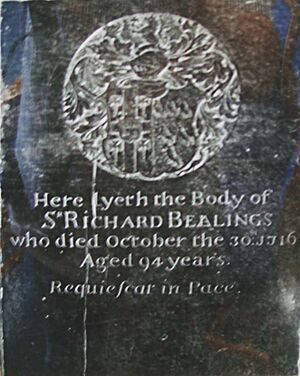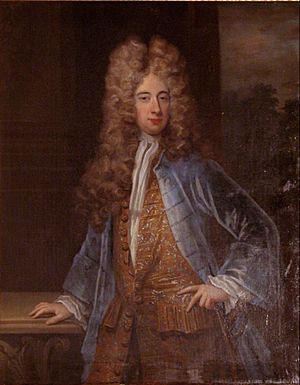Richard Bellings (courtier) facts for kids
Sir Richard Bellings (born in 1622, died in 1716) was an important Irish helper to the royal family. He worked as the main secretary for Catherine of Braganza, who was the queen of King Charles II. Sir Richard was one of several Irish Catholics who were given jobs in England after the king returned to power in 1660. This period is known as the Restoration.
In 1662, King Charles II sent Sir Richard Bellings to Rome, a city in Italy. His job was to discuss how England might become a Catholic country again.
Secret Treaty of Dover
On June 1, 1670, Sir Richard Bellings was one of the people who signed a very important agreement for England. This was called the Secret Treaty of Dover. Other people who signed it included Henry Bennet, 1st Earl of Arlington and Sir Thomas Clifford for England. Jean-Baptiste Colbert signed for France.
This secret treaty said that King Charles II would announce that he was a Catholic. In return, the King of France, Louis XIV, would pay him two million francs. If there were any problems or fights in England because of this, France would also send military help.
Signing this treaty created a strong alliance between England and France. This alliance was against Holland. It led to the second Dutch War during King Charles II's rule, which started in March 1672.
Family Life
Sir Richard Bellings's father, also named Richard Bellings (1603–1677), was a lawyer and a political figure in Ireland during the 1600s. His mother was Margaret Butler.
In 1671, Sir Richard Bellings married Francis Arundell. She was the daughter of Sir John Arundell and also worked as a gentlewoman for Queen Catherine. Their son, Richard, later added "Arundell" to his last name, becoming Bellings-Arundell. He did this because of his grandfather's will.
Children of Sir Richard Bellings
- Richard Bellings-Arundell married Anne Gage. She was the daughter of Joseph Gage from Sherborne Castle.
- Helen married Sir John Hales, 4th Baronet.
Sir Richard Bellings was buried in a place called St Columb Major in Cornwall, England. His headstone has a special design called a coat of arms.



